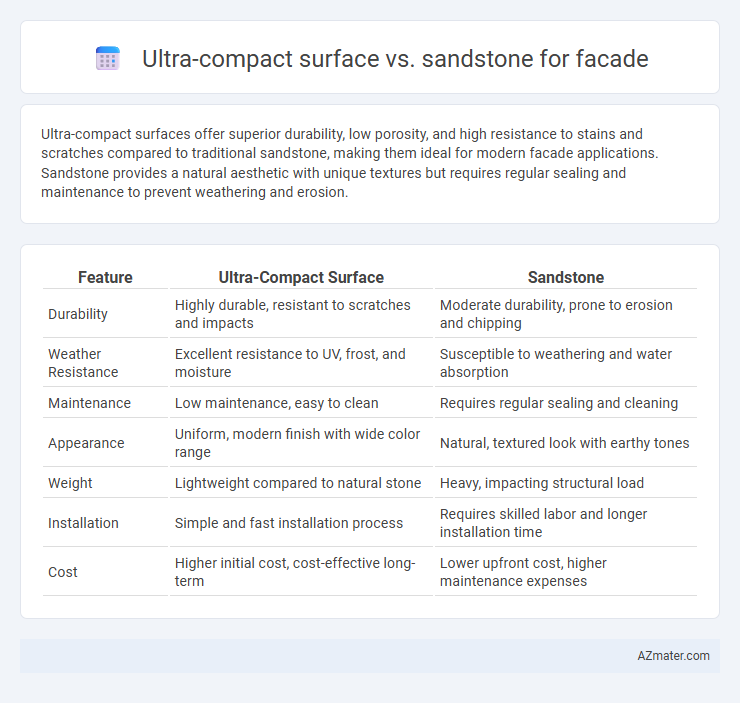Ultra-compact surfaces offer superior durability, low porosity, and high resistance to stains and scratches compared to traditional sandstone, making them ideal for modern facade applications. Sandstone provides a natural aesthetic with unique textures but requires regular sealing and maintenance to prevent weathering and erosion.
Table of Comparison
| Feature | Ultra-Compact Surface | Sandstone |
|---|---|---|
| Durability | Highly durable, resistant to scratches and impacts | Moderate durability, prone to erosion and chipping |
| Weather Resistance | Excellent resistance to UV, frost, and moisture | Susceptible to weathering and water absorption |
| Maintenance | Low maintenance, easy to clean | Requires regular sealing and cleaning |
| Appearance | Uniform, modern finish with wide color range | Natural, textured look with earthy tones |
| Weight | Lightweight compared to natural stone | Heavy, impacting structural load |
| Installation | Simple and fast installation process | Requires skilled labor and longer installation time |
| Cost | Higher initial cost, cost-effective long-term | Lower upfront cost, higher maintenance expenses |
Introduction to Façade Material Choices
Ultra-compact surfaces and sandstone represent two distinct facade material choices with unique properties influencing architectural aesthetics and durability. Ultra-compact surfaces offer exceptional resistance to weather, stains, and abrasion, making them ideal for modern constructions requiring low maintenance and high performance. In contrast, sandstone provides natural texture and warmth, favored for traditional designs but demands more upkeep due to its porous nature and susceptibility to erosion over time.
What is Ultra-Compact Surface?
Ultra-compact surface is an advanced engineered material composed of natural minerals compressed under extreme pressure and high temperatures, resulting in a highly durable, non-porous, and stain-resistant facade solution. Compared to sandstone, ultra-compact surfaces offer superior resistance to weathering, UV rays, and mechanical wear, making them ideal for long-lasting exterior cladding. Its lightweight and thin profile provide design versatility alongside easier installation and maintenance.
Defining Sandstone as a Façade Material
Sandstone, a natural sedimentary rock composed primarily of sand-sized mineral particles, is prized for its durability and aesthetic appeal in facade applications, offering a warm, earthy texture that varies in color and pattern. Ultra-compact surfaces, engineered from a blend of natural minerals and resins, provide a highly durable, non-porous alternative with superior resistance to stains, weathering, and UV radiation compared to traditional sandstone. While sandstone delivers authentic natural beauty and excellent thermal insulation, ultra-compact surfaces excel in low maintenance and enhanced longevity, making the choice dependent on design priorities and environmental conditions.
Durability Comparison: Ultra-Compact Surface vs Sandstone
Ultra-compact surfaces exhibit superior durability compared to sandstone in facade applications, resisting scratches, stains, and weathering more effectively due to their dense, non-porous composition. Sandstone, a natural stone, is more porous and susceptible to erosion, discoloration, and chemical damage over time, requiring more frequent maintenance and sealing. The ultra-compact material's resistance to UV rays and frost further enhances its longevity, making it a more reliable choice for long-term exterior cladding.
Aesthetic Appeal and Design Flexibility
Ultra-compact surfaces offer a sleek, modern aesthetic with consistent color and texture, making them ideal for contemporary facade designs that require a high degree of uniformity and minimal maintenance. Sandstone provides a natural, warm appearance with unique grain patterns and color variations, enhancing traditional or rustic architectural styles through organic visual appeal. Design flexibility is higher with ultra-compact surfaces due to their thin profile, lightweight nature, and ability to be cut into precise shapes, whereas sandstone's heavier weight and irregularities limit customization but add character and tactile richness.
Weather Resistance and Environmental Performance
Ultra-compact surfaces exhibit superior weather resistance compared to sandstone, boasting high density and low porosity that prevent water absorption, frost damage, and erosion over time. Their composition enables exceptional durability against UV rays, temperature fluctuations, and pollutants, reducing maintenance costs and extending facade lifespan. Environmentally, ultra-compact surfaces are often produced with recycled materials and require less frequent replacement, contributing to sustainability and lower carbon footprints in building projects.
Installation and Maintenance Considerations
Ultra-compact surfaces offer a lightweight and thin profile, enabling faster and more precise installation on facades compared to traditional sandstone, which is heavier and requires robust support structures. Maintenance for ultra-compact surfaces is simplified due to their high resistance to stains, scratches, and weathering, reducing the need for frequent cleaning and repairs unlike sandstone that demands regular sealing and prone to erosion. Choosing ultra-compact materials minimizes long-term costs and labor associated with facade upkeep while ensuring durability and aesthetic consistency.
Cost Analysis and Long-Term Value
Ultra-compact surfaces generally offer higher upfront costs compared to sandstone due to advanced manufacturing processes and material durability. Sandstone has lower initial expenses but requires more frequent maintenance, impacting long-term value negatively. Over time, ultra-compact surfaces provide superior cost efficiency through enhanced resistance to weathering, stains, and mechanical wear, reducing replacement and repair expenses.
Sustainability and Eco-Friendly Attributes
Ultra-compact surfaces exhibit superior sustainability compared to sandstone due to their low porosity, reducing water absorption and limiting the need for chemical treatments, thus enhancing durability and minimizing environmental impact. Manufactured using recycled materials and offering longer lifespans, ultra-compact surfaces contribute to waste reduction and resource efficiency, whereas sandstone extraction often results in habitat disruption and higher carbon emissions. The maintenance requirements of ultra-compact surfaces involve fewer harmful cleaning agents, reinforcing their eco-friendly profile over natural sandstone cladding in facade applications.
Conclusion: Choosing the Right Façade Material
Ultra-compact surfaces provide superior durability, low maintenance, and resistance to weathering, making them ideal for modern facades requiring sleek aesthetics and high performance. Sandstone offers natural beauty and unique texture but demands more upkeep due to its porosity and vulnerability to erosion over time. Selecting the right facade material depends on prioritizing longevity and minimal care with ultra-compact surfaces or valuing natural appearance and traditional charm with sandstone.

Infographic: Ultra-compact surface vs Sandstone for Façade
 azmater.com
azmater.com